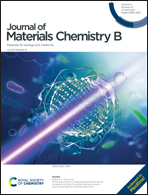Improved in vivo stability of silicon-containing polyurethane by fluorocarbon side chain modulation of the surface structure†
Abstract
As a class of widely used biomedical materials, polyurethanes suffer from their insufficient stability in vivo. Although the commercialized silicone-polyetherurethanes (SiPEUs) have demonstrated excellent biostability compared with polyetherurethanes (PEUs) for long-term implantation, the usage of polydimethylsiloxane (PDMS) inevitably decreased the mechanical properties and unexpected breaches were observed. In this study, we introduced a fluorinated diol (FDO) into SiPEU to modulate the molecular interactions and micro-separated morphology. The fluorinated silicon-containing polyurethane (FSiPEU) was achieved with desirable silicone- and fluorine-enriched surfaces and mechanical properties at a low silicon content. As evidenced by in vitro culture of macrophages and in vivo hematoxylin–eosin (H&E) staining, FSiPEU demonstrated a minimized inflammatory response. After implantation in mice for 6 months, the material was devoid of significant surface degradation and had the least chain cleavage of soft segments. The results indicate that FSiPEU could be promising candidates for long-term implantation considering the combination of biostability, biocompatibility and mechanical performances.



 Please wait while we load your content...
Please wait while we load your content...